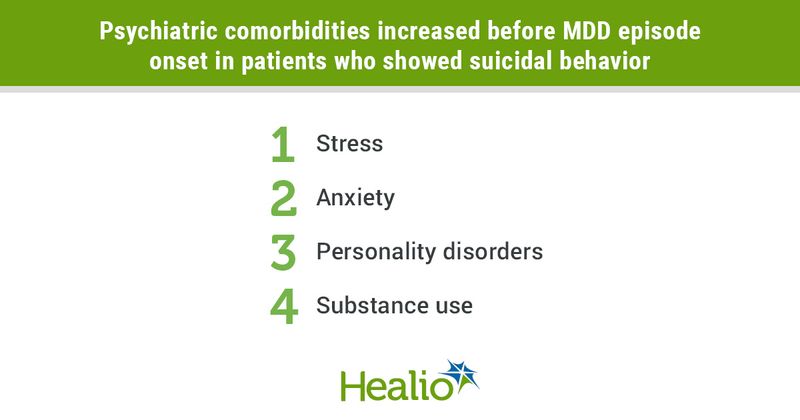All-cause mortality doubled in adults with major depressive disorder, suicidal behavior
Key takeaways:
- Patients with major depressive disorder who showed suicidal behavior had a 2.62 hazard ratio for all-cause mortality.
- Risk factors for suicidal behavior included age, substance use and sleep disorders.
Suicidal behavior was associated with more than twice the risk for all-cause mortality in patients with major depressive disorder, as well as increased work loss and health care resource utilization, according to a Swedish study.
Adult patients with major depressive disorder (MDD) who exhibited suicidal behavior had a hazard ratio of 2.62 (95% CI, 2.15-3.2) for all-cause mortality vs. those who did not show suicidal behavior, researchers wrote in JAMA Psychiatry.

The population-based cohort study also concluded that the most important risk factors for suicidal behavior in the first year of an MDD episode included history of suicidal behavior, age, substance use, sleep disorders and the care setting where MDD was diagnosed.
The goal of the study was to examine all-cause mortality and other outcomes associated with suicidal behavior in patients with MDD. It also aimed to identify risk factors and lay the groundwork for evidence-based guidelines for optimizing treatments to avoid suicidal behavior.
The study drew on health care data from the Stockholm MDD Cohort to analyze 2,240 MDD episodes with at least one record of suicidal behavior, defined as intentional self-harm, between Jan. 1, 2012, and Dec. 31, 2017. When a patient first showed suicidal behavior during an episode, they were matched and compared with up to five patients with MDD and no suicidal behavior.
The suicidal behavior group’s all-cause mortality rate was 2.5 per 100 person-years at risk, compared with 1 per 100 person-years at risk in the non-suicidal behavior group, which corresponded to a hazard ratio of 2.62 for the suicidal behavior group, the study said.
Researchers reported greater work loss and health care resource utilization among the suicidal behavior group over the year leading up to their suicidal behavior, measured as:
- more workdays lost (mean, 87.1 vs. 53);
- more outpatient physician visits (mean, 11.4 vs. 7.7); and
- more inpatient bed days (mean, 11.1 vs. 2.1).
The suicidal behavior group also experienced more pronounced increases in stress, anxiety, personality disorders and substance use before MDD episode onset than the group without suicidal behavior.
The most important risk factors for suicidal behavior within 1 year after onset of an MDD episode were history of suicidal behavior and age, with the highest risks for those aged younger than 20 years or older than 70 years. In descending order of risk, the other factors were:
- history of substance use;
- history of sleep disorders;
- health care level in which MDD was diagnosed, with greater risk from a psychiatric care diagnosis than non-psychiatric care diagnosis;
- history of antidepressant use; and
- history of anxiety disorders.
Researchers created a model, presented as a nomogram, for the prediction of suicidal behavior within 1 year after onset of an MDD episode. The model should be used only as a complement to a thorough clinical evaluation, they wrote, noting that family history of psychiatric conditions and other important variables were not included.
Possible limitations arose from the study’s exclusion of patients with bipolar disorder, dementia or psychosis, and the suicidal behavior group’s exclusion of diagnoses of harm of undetermined intent. Researchers also noted that their counting methods “might have slightly overestimated the number of suicidal behavior episodes, which should be contrasted to previous reports that suicidal behavior is underdiagnosed.”
